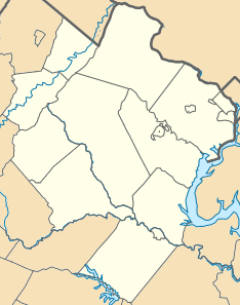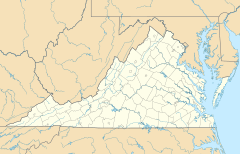Taylorstown, Virginia facts for kids
Quick facts for kids
Taylorstown, Virginia
|
|
|---|---|
| Country | |
| State | |
| County | |
| Time zone | UTC−5 (Eastern (EST)) |
| • Summer (DST) | UTC−4 (EDT) |
Taylorstown is a small community in Loudoun County, Virginia. It sits by Catoctin Creek, about two miles (3 km) south of the Potomac River. The area was first settled in 1734. It is home to two of Loudoun County's oldest houses, "Hunting Hill" and "Foxton Cottage". These houses are located on opposite sides of Catoctin Creek.
The main part of the village is called the Taylorstown Historic District. It was added to the National Register of Historic Places in 1978. The district was later expanded in 2005.
Contents
History of Taylorstown
The first person to live in the Taylorstown area was Richard Brown. He was a Quaker, a member of a Christian group known for its peaceful beliefs. Richard Brown arrived in the 1730s from Bucks County, Pennsylvania. He wanted to build a mill.
He found Catoctin Creek to be a perfect spot. Richard bought a large piece of land, hundreds of acres, that stretched from the Potomac River south to Lincoln. In 1734, Brown built a small house. This house would later be called Hunting Hill. It is still the oldest standing building in Loudoun County.
Richard Brown passed away in 1745. He divided his land among his wife and five sons. His wife received the land that included the Taylorstown area and its buildings. She later gave this land to her youngest son, Mercer Brown. In 1784, Mercer Brown sold the land.
The buyer was Thomas Taylor. He was a wealthy Quaker from Frederick County, Maryland. Thomas Taylor was also very interested in running a mill.
Building the Mill and Naming the Town
While living at Hunting Hill, Thomas Taylor built a new mill. It was made of local stone. The mill was about 50 yards north of the first mill site. Today, it is known as the Taylorstown Mill.
Many people helped build the mill. Some were enslaved people from nearby farms. They were hired when their owners could spare them. They were paid wages, following the Quaker customs of the time. You can still see many initials and names carved into the mill's stones. Perhaps these were left by the builders or their employers.
After the mill was finished, Taylor sold small plots of land. These plots were a quarter-acre each. New settlers bought these plots around the mill. They called the area Taylor Town. Around 1900, the name became Taylorstown.
The Taylorstown Mill operated continuously until 1911. Its water wheel was sold to the nearby Oatlands Mill. The Taylorstown Mill then started using steam power. In 1932, the steam engines were removed. The mill became a feed store. In the late 1950s, Anna Hedrick bought it. Since the late 1960s, the Taylorstown Mill has been a private home.
Another private home, called Whiskey Hill, was built in the late 1700s.
Growth of the Community
Taylorstown grew from a small settlement into a busy farming community. This growth happened over about 100 years. Farming and milling were the biggest reasons for its growth. There were at least three mills in the area.
Iron mining from nearby Furnace Mountain also helped the community grow. Miners came to the area in the late 1700s and early 1800s. You can still find traces of the old mining operations today. The furnace used to separate iron from the ore was near the Potomac River. A tunnel brought water from Catoctin Creek to power its bellows.
In the 1800s, the Taylorstown area was one of the most populated parts of Loudoun County. The town had many services. It had a post office, a blacksmith's shop, and two mills (one is still standing). There was also a U.S. Government-operated still, general stores, and a movie theater. Records also show schools, like the Crossroads School built in 1834. This school was near Waterford Downs until the 1940s.
Challenges During the Civil War
Many of Taylorstown's first residents were Quakers. They often supported the Northern states during the American Civil War. Some helped Northern forces. They would secretly move food and supplies across the Potomac River.
Because of this, a group of Confederate soldiers attacked the locals. They burned down the mill. They also destroyed the only bridge across Catoctin Creek.
Protecting Taylorstown: The Dam Proposal
In 1974, the citizens of Taylorstown formed a group. They called it the Catoctin Valley Defense Alliance. This group became very active. They worked to stop a plan to build a dam on Catoctin Creek.
The Fairfax Water Authority, the Washington, D.C. Government, and the Washington Commission had a plan. They wanted to build a dam to provide water during droughts. Their plan said that 3,280 acres (13 km2) of the lower Catoctin Valley was the best place for a water supply.
A dam would be built where Catoctin Creek flows into the Potomac. This would create a five-mile (8 km) long lake. It would be 364 feet (111 m) deep. The lake could hold 14 billion US gallons (53 million m3) of water. This water could be released during a drought. It would make the Potomac River swell. This would provide emergency water to Washington, D.C. If built, the dam would destroy the Taylorstown Historic District.
Community Action and Success
The local community joined the Catoctin Valley Defense Alliance. They worked together to stop this "feeder lake." During this time, many local cars had red bumper stickers. They said "Don't Dam Taylorstown." This message later changed to "Don’t Dam Loudoun." This happened when it became clear that more land outside Taylorstown was also in danger.
Phil Erenkranz and Miss Anna Hedrick were two lawyers. They were active in the Defense Alliance. They went to the Virginia General Assembly in Richmond. They helped pass a new state law in Virginia. This law said that one county could not take land from another county without permission. This is called "eminent domain."
Because of this new law, Fairfax County and Washington, D.C. could no longer legally take water or anything else from Loudoun County without permission. The engineers could not build their dam.
To protect the community from future threats, citizens sought more laws. Catoctin Creek was named a State Scenic River. The center of Taylorstown was registered as a historical location. This was done under the Historical Preservation Act.
Taylorstown Today
Today, Taylorstown is a community of about four thousand people. In the 2000 census, 3,216 people were recorded. This number has grown a lot since then. Most residents live within a three-mile (5 km) circle of the original town center.
Taylorstown is no longer an official town in Virginia. It has been loosely divided among nearby towns. These include Leesburg, Lovettsville, Lucketts, and Waterford. This can sometimes cause confusion with government services. Some residents might have one town's address. They might have another town's phone number. Their children might go to school in a different district. This depends on the nearest bus route.
The people living in Taylorstown come from many different economic backgrounds. Some residents are artists. Others live in very expensive homes. Most people are somewhere in between. It is easy to get to the MARC commuter train. This has brought many residents who travel to work in Washington, D.C. every day. The train ride takes about an hour.
National Register of Historic Places
The Taylorstown Historic District was added to the National Register of Historic Places on January 30, 1978. The district was expanded on May 26, 2005.




